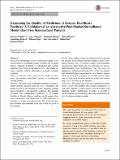Examining the Quality of Medicines at Kenyan Healthcare Facilities: A Validation of an Alternative Post-Market Surveillance Model That Uses Standardized Patients
View/
Publication Date
2016-11-25Type
Article, Journalviews
downloads
Metadata
Show full item recordCitation
Wafula, F., Dolinger, A., Daniels, B. et al. Examining the Quality of Medicines at Kenyan Healthcare Facilities: A Validation of an Alternative Post-Market Surveillance Model That Uses Standardized Patients. Drugs - Real World Outcomes 4, 53–63 (2017). https://doi.org/10.1007/s40801-016-0100-7
Abstract/
Background Promoting access to medicines requires concurrent efforts to strengthen quality assurance for sustained impact. Although problems of substandard and falsified medicines have been documented in low- and middle-income countries, reliable information on quality is rarely available. Objective The aim of this study was to validate an alternative post-market surveillance model to complement existing models. Methods The study used standardized patients or mystery clients (people recruited from the local community and trained to pose as real patients) to collect medicine samples after presenting a pre-specified condition. The patients presented four standardized conditions to 42 blinded facilities in Nairobi, Kenya, resulting in 166 patient–clinician interactions and dispensing of 300 medicines at facilities or nearby retail pharmacies. The medicine samples obtained thus resemble those that would be given to real patients. Results Sixty samples were selected from the 300, and sent for analysis at the Kenya National Quality Control Laboratory. Of these, ten (17%) did not comply with monograph specifications (three ibuprofen, two cetirizine, two amoxicillin/clavulanic acid combinations, and one each for prednisone, salbutamol and zinc). Five of the ten samples that failed had been inappropriately prescribed to patients who had presented symptoms of unstable angina. There was no association between medicine quality and ownership, size or location of the facilities. Conclusion The study shows that the standardized patient model can provide insights into multiple dimensions of care, thus helping to link primary care encounters with medicine quality. Furthermore, it makes it possible to obtain medicines from blinded sellers, thus minimizing the risk of obtaining biased samples.
Further Details
@The Author(s) 2016. This article is published with open access at Springerlink.com. This article is distributed under the terms of theCreative Commons Attribution-NonCommercial 4.0 InternationalLicense (http://creativecommons.org/licenses/by-nc/4.0/), which per-mits any noncommercial use, distribution, and reproduction in anymedium, provided you give appropriate credit to the originalauthor(s) and the source, provide a link to the Creative Commonslicense, and indicate if changes were made
Publisher
SpringerLinkCollections
- General - GEN [367]

